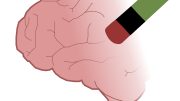Locked-in syndrome is a terrifying condition where an individual’s senses, such as sight, hearing and touch, are intact, but they are physically paralyzed — they hear, see and feel but they cannot respond. A Belgian man, Rom Houben, 46, made international headlines at the end of 2009, after a study investigating the misdiagnosis of consciousness disorders was published. Doctors say Houben, who was in a motor vehicle accident 23 years ago, was misdiagnosed as being in a persistent vegetative state. They now believe that Houben has been suffering from locked-in syndrome for the past 23 years, and that he is now able to communicate. Houben’s doctors came to this conclusion after studying the results of recent brain scans, utilizing techniques that were not available at the time of Houben’s accident, and the results from a procedure known as “facilitated communication” (FC).
Facilitated communication was first used in a clinical setting in 1977 when Rosemary Crossley, an Australian author, came up with the concept that people who are unable to speak, such as individuals with severe autism, could communicate by using a keyboard. During FC a person known as the “facilitator” supports (literally, grasping) the hand of the communicator, sensing the very slight movements of the individual’s hand toward a correct key, or resistance from attempting to press an incorrect key, so as to type out a message. Crossley wrote three books chronicling her experience with implementing FC for children with autism.
Behavioural psychologists Jon Bailey and Mary Burch, in their book “How to Think Like a . . . Behavior Analyst,” recount a story about a speaker at a psychology conference in San Francisco who caught the attention of the audience when reporting on her work with autistic youths using FC in America. Bailey and Burch wrote, “What was missing from this presentation was any actual data of any kind, except for a typed poem. By the way, the poem had no spelling errors, no typos, and no grammatical errors.” Bailey and Burch wonder how children, who have not shown any prior acquisition of expressive language, suddenly became not only proficient in written English, but artistic poets?
One possible explanation for the results produced by FC is ideomotor effect — a phenomenon occurring when someone (other than the expected thing/person) is responsible for unconsciously moving something. University of Pennsylvania bioethics professor Arthur Caplan likens the ideomotor effect and FC to a children’s game: “It’s Ouija board stuff. It’s been discredited time and again when people look at it.” Caplan refers to the numerous studies that have demonstrated the facilitator as the person who inadvertently made the statements during FC sessions, not the patient.
Unfortunately, there have been hundreds of news reports from around the world, which claim that Houben has unequivocally been awake and aware for the past 23 years. On his blog, Respectful Insolence, noted surgeon/scientist/skeptic/anonymous blogger “Orac” says, in response to the recent coverage of FC, that it is a “contender for the worst medical reporting ever.”
The first of the recent reports covering Houben’s condition appeared on Nov. 23, 2009, in the Daily Mail. The article quotes Houben as “saying” (as opposed to typing with facilitation), “I screamed, but there was nothing to hear.” Independently, both Raf Casert, reporting for the Huffington Post, and Kate Connolly, for the Guardian, wrote that Houben “now communicat[es] with one finger and a special touch screen on his wheelchair.” Neither report mentioned the facilitator even being present. In fact, virtually every newspaper and major news network failed to mention the controversy surrounding FC.
Houben’s doctors support their claim of FC with the fact that his brain, when scanned, was seen to be almost fully functional. The journal Nature describes the brain-mapping techniques used on Houben as a detection of brain regions that light up in response to external stimuli. But University of Minnesota professor, Paul Zachary Meyers, is quick to point out that “there’s more to consciousness than that,” in a post on his blog, Pharyngula. Indeed, psychologists make a distinction between sensation and perception, the latter of which is more questionable in Houben’s case. Ben Goldacre, a psychiatrist writing for the Guardian, also notes that the predictive value of the recently developed brain scanning techniques used on Houben are not entirely known.
“The problem is that the communication shown on these videos is simply impossible,” says Stephen Novella, on the blog Neurologica (regarded as one of the top neuroscience blogs on the net, by the site Thedailyreviewer.com). Novella goes on to say, “His hand is also in a brace; his finger is not touching the board — the plastic of the brace is — so he would have little sensory feedback.” As a little experiment, why don’t you try typing this, with just one finger, eyes closed: “I screamed, but there was nothing to hear.”
No one knows if Houben is truly suffering from locked-in syndrome, but if demonstrating FC produces false messages makes a difference to the re-diagnosis, then it’s worth it to take the time to conduct a controlled test. Jim Lippard, a frequent contributor to Skeptic Magazine, notes, “There is no harm to Houben from such a test, though there’s clearly the risk of painfully dissolving an illusion for the doctor, facilitator and family. But Hoeben’s interests should be placed above that risk.”


